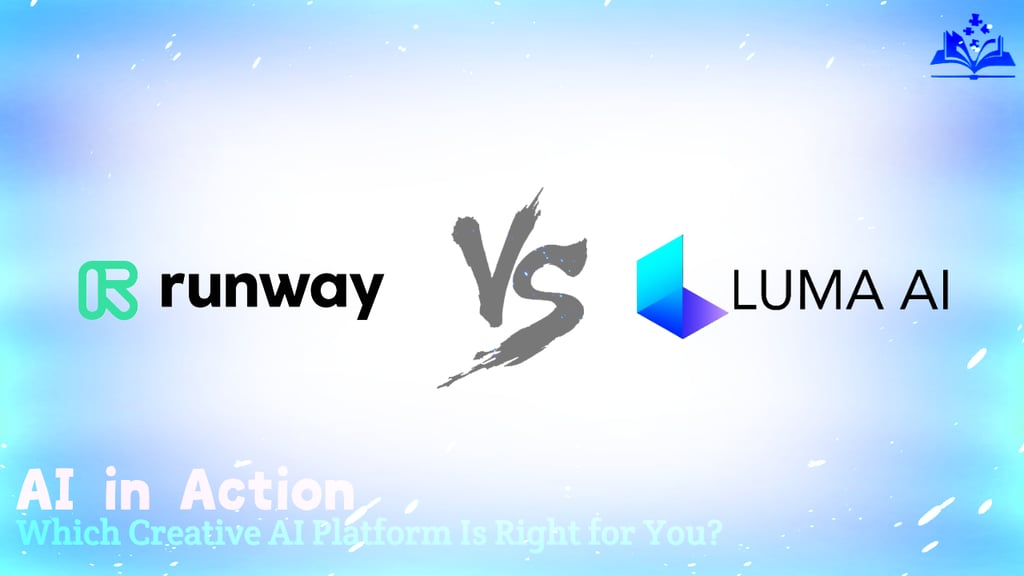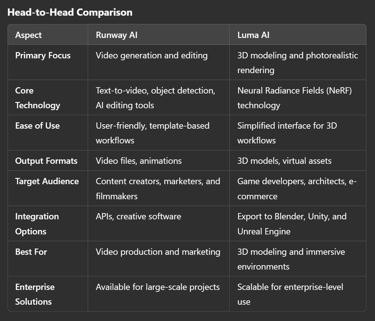
Runway AI vs Luma AI: Which Creative AI Platform Is Right for You?
A Comprehensive Comparison of AI Tools for Creative Industries" Discover the key differences, features, use cases, and industry implications of Runway AI vs Luma AI. Learn how these cutting-edge AI platforms empower content creators, filmmakers, game developers, and architects to produce stunning visuals and interactive experiences.
AI/FUTUREEDITOR/TOOLSAI ART TOOLSARTIST/CREATIVITY
Sachin K Chaurasiya
1/5/20254 min read


The rapid advancement of artificial intelligence has opened new doors in creative industries, from video editing and 3D modeling to text-to-video generation. Runway AI and Luma AI stand out as two prominent platforms that cater to creative professionals and enthusiasts. While both are AI-powered tools, they serve distinct purposes and offer unique features. This article explores their key functionalities, strengths, and differences to help you make an informed decision.
What is Runway AI?
Runway AI is an innovative platform that focuses on democratizing content creation through artificial intelligence. It provides a suite of tools that empower users to create videos, animations, and other multimedia projects with minimal technical expertise.
Key Features
Text-to-Video Generation: Runway AI’s standout feature is its ability to transform textual descriptions into videos. Users can describe a scene or action, and the AI generates a video based on the input.
Video Editing with AI: Runway AI enables frame interpolation, background removal, and object tracking—all powered by cutting-edge AI algorithms.
Collaboration-Friendly: It integrates seamlessly with other software and allows collaborative workflows, making it ideal for teams.
Extensive Templates: The platform includes pre-built templates to speed up the creative process.
Generative Tools: Beyond videos, Runway AI offers generative capabilities for images and creative content, making it versatile for multimedia projects.
API Integration: For developers, Runway AI provides APIs to integrate its capabilities into custom applications.
Real-Time Rendering: Allows users to preview changes instantly, accelerating the creative process.
AI Models Marketplace: Features a marketplace for pre-trained AI models that can be adapted for specific projects.
Use Cases
Marketing and advertising professionals seeking to create engaging video campaigns.
Filmmakers and animators need quick prototyping tools.
Social media creators who want AI-generated content for platforms like TikTok or Instagram.
Educational content developers create engaging visual aids.
Businesses are leveraging AI for branded content creation.
Strengths
Accessibility: Ideal for those with little to no technical expertise.
Speed: Quickly generates videos, animations, and effects.
Collaboration: Built for creative teams and content agencies.
Broad Applicability: Can be used across various creative domains, including advertising, education, and social media.
Custom AI Models: Offers flexibility for unique project requirements.
Limitations
Focuses on 2D content, lacking 3D modeling capabilities.
May not meet the needs of users seeking hyper-detailed or custom workflows.
Choosing the Right Platform
Content creators focus on short-form or promotional videos.
Social media influencers who need quick and easy video tools.
Teams collaborating on video production projects.
Educators create visually engaging content.
Businesses are leveraging branded video content.


What is Luma AI?
Luma AI specializes in 3D content creation, leveraging photorealistic rendering and NeRF (Neural Radiance Fields) technology. It caters to industries where 3D modeling and visualization are crucial, such as gaming, virtual reality, and architecture.
Key Features
Photorealistic 3D Models: Luma AI excels in generating detailed 3D models from simple 2D images or video scans.
NeRF Technology: By using advanced neural radiance fields, Luma AI creates highly accurate representations of real-world objects and environments.
Intuitive User Interface: Its easy-to-use platform makes complex 3D modeling accessible to non-experts.
Integration with 3D Workflows: Luma AI supports exporting models to other 3D design software like Blender, Unity, or Unreal Engine.
Real-Time Previews: Luma AI allows users to preview their 3D creations in real time, enhancing efficiency and accuracy.
Cloud-Based Functionality: Users can work seamlessly across devices, leveraging cloud processing for high-quality outputs.
High Fidelity Texturing: Ensures models are rendered with realistic textures, enhancing the final output.
Scalable for Enterprise Use: Offers solutions tailored for large-scale projects in gaming, real estate, and more.
Use Cases
Game developers design immersive environments.
Architects and real estate professionals are creating virtual walkthroughs.
E-commerce brands needing 3D product models for interactive displays.
Virtual and augmented reality developers are crafting lifelike simulations.
Film studios create CGI assets for blockbuster productions.
Strengths
Photorealism: Produces lifelike 3D models that are ready for advanced applications.
Innovation in 3D: Pioneers in NeRF technology for detailed visualizations.
Interoperability: Compatible with professional-grade 3D software.
Industry-Specific Solutions: Designed for industries requiring high-quality 3D visuals, such as gaming and architecture.
Real-World Applications: Supports augmented and virtual reality projects.
Limitations
Not designed for video editing or animation.
It requires some understanding of 3D modeling workflows for advanced projects.
Choosing the Right Platform
Professionals in the gaming and VR industries requiring high-quality 3D assets.
Architects and designers showcase projects in virtual environments.
E-commerce brands are aiming for interactive product displays.
AR/VR developers craft immersive experiences.
Film producers requiring detailed 3D visual effects.


Industry Implications
Both platforms signify a broader trend in the democratization of creative tools. Runway AI empowers video creators to produce professional-grade content without the need for extensive resources or expertise. Luma AI, on the other hand, pushes the boundaries of 3D modeling, making it more accessible to industries beyond traditional gaming or architecture.
The intersection of these technologies also opens possibilities for hybrid workflows. For instance, a filmmaker could use Runway AI for video content and integrate Luma AI’s 3D models into scenes for a more immersive narrative. This synergy showcases the complementary potential of these platforms.
The rise of AI-powered platforms like these also impacts job roles and workflows. Creative professionals now focus more on conceptualization and storytelling, with AI handling the technical execution. This shift not only speeds up production but also fosters innovation by lowering entry barriers.
Both Runway AI and Luma AI cater to creative minds, but in vastly different domains. Runway AI excels in video production and AI-driven animation, while Luma AI stands out in 3D modeling and photorealism. Your choice ultimately depends on the type of content you aim to create and the industry you belong to.
As AI continues to revolutionize creative industries, platforms like Runway AI and Luma AI are leading the charge, proving that technology can bring imagination to life with unprecedented ease and efficiency.
Subscribe to our newsletter
All © Copyright reserved by Accessible-Learning
| Terms & Conditions
Knowledge is power. Learn with Us. 📚


